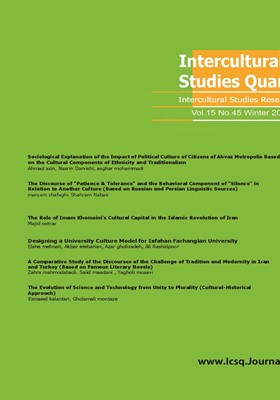-
-
List of Articles
-
Open Access Article
1 - Sociological Explanation of the Impact of Political Culture of Citizens of Ahvaz Metropolis Based on the Cultural Components of Ethnicity and Traditionalism
AHMAD AZIN , Nasrin Darvishi asghar mohammadi -
Open Access Article
2 - The Discourse of "Patience & Tolerance" and the Behavioral Component of "Silence" in Relation to Another Culture (Based on Russian and Persian Linguistic Sources)
maryam shafaghi Shahram Nabati -
Open Access Article
3 - The Role of Imam Khomeini's Cultural Capital in the Islamic Revolution of Iran
Majid Ostovar -
Open Access Article
4 - Designing a University Culture Model for Isfahan Farhangian University
elahe mehnati akbar etebarian azar gholizadeh Ali Rashidpoor -
Open Access Article
5 - A Comparative Study of the Discourses of the Challenge of Tradition and Modernity in Iran and Turkey (Based on Famous Literary Novels)
zahra mahmodabadi saiid maadani YAGHOB MOSAVI -
Open Access Article
6 - The Evolution of Science and Technology from Unity to Plurality (Cultural-Historical Approach)
esmaeel kalantari gholamali montazer
-
The rights to this website are owned by the Raimag Press Management System.
Copyright © 2021-2025







